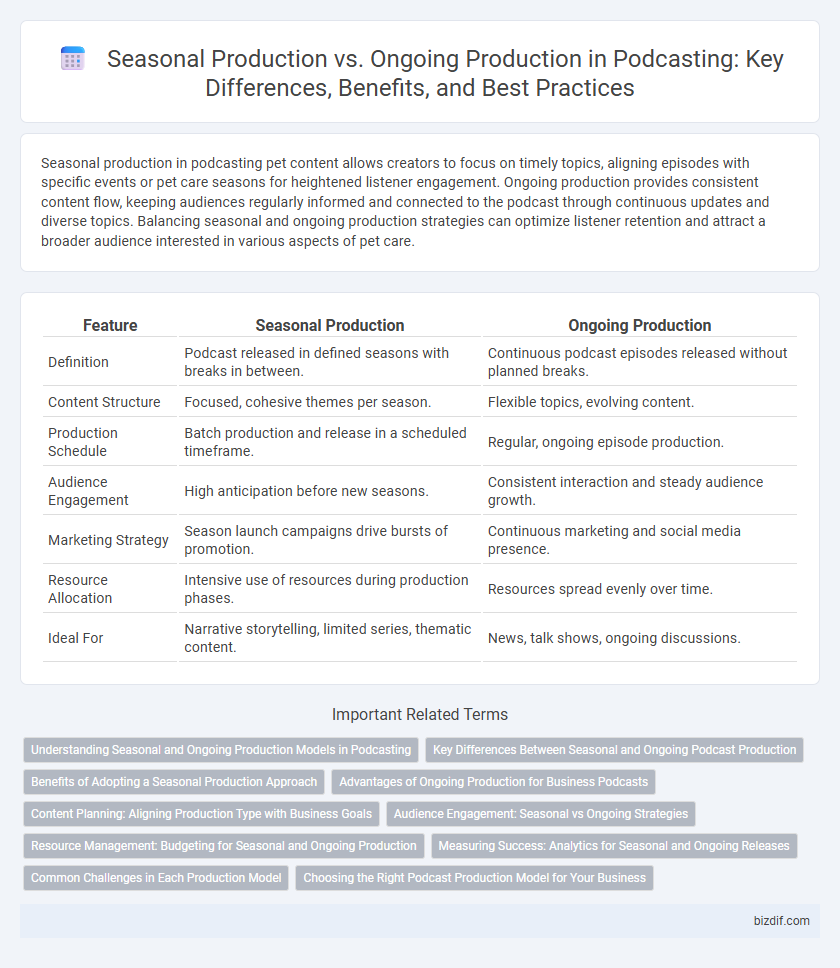Seasonal production in podcasting pet content allows creators to focus on timely topics, aligning episodes with specific events or pet care seasons for heightened listener engagement. Ongoing production provides consistent content flow, keeping audiences regularly informed and connected to the podcast through continuous updates and diverse topics. Balancing seasonal and ongoing production strategies can optimize listener retention and attract a broader audience interested in various aspects of pet care.
Table of Comparison
| Feature | Seasonal Production | Ongoing Production |
|---|---|---|
| Definition | Podcast released in defined seasons with breaks in between. | Continuous podcast episodes released without planned breaks. |
| Content Structure | Focused, cohesive themes per season. | Flexible topics, evolving content. |
| Production Schedule | Batch production and release in a scheduled timeframe. | Regular, ongoing episode production. |
| Audience Engagement | High anticipation before new seasons. | Consistent interaction and steady audience growth. |
| Marketing Strategy | Season launch campaigns drive bursts of promotion. | Continuous marketing and social media presence. |
| Resource Allocation | Intensive use of resources during production phases. | Resources spread evenly over time. |
| Ideal For | Narrative storytelling, limited series, thematic content. | News, talk shows, ongoing discussions. |
Understanding Seasonal and Ongoing Production Models in Podcasting
Seasonal production in podcasting involves creating content in defined batches or seasons, often centered around a specific theme or story arc, allowing for focused marketing and audience anticipation. Ongoing production releases episodes continuously, maintaining consistent engagement and enabling real-time content relevance. Understanding these models helps podcasters strategically plan content delivery, balance workload, and grow audience retention based on show format and listener expectations.
Key Differences Between Seasonal and Ongoing Podcast Production
Seasonal podcast production involves creating a finite series of episodes centered around a specific theme or story arc, allowing for in-depth research and polished editing. Ongoing podcast production features continuous content with regular releases, fostering consistent audience engagement and flexibility in topics. Key differences include production scheduling, content planning, and audience retention strategies, where seasonal podcasts emphasize narrative closure and ongoing podcasts prioritize adaptability and sustained listener interaction.
Benefits of Adopting a Seasonal Production Approach
Seasonal production in podcasting allows creators to focus on a cohesive narrative arc, enhancing storytelling quality and listener engagement by delivering content in structured, thematic batches. This approach facilitates efficient resource management, enabling better planning, editing, and marketing strategies tailored to specific release periods. Concentrated release schedules also boost audience anticipation and provide clear entry points for new listeners, which can drive higher retention rates compared to continuous, ongoing production models.
Advantages of Ongoing Production for Business Podcasts
Ongoing production in business podcasts ensures consistent audience engagement by regularly delivering fresh content that builds brand authority and listener loyalty. This approach allows for timely responses to industry trends and customer feedback, enhancing relevance and trust. Continuous episodes also improve SEO performance and provide more opportunities for cross-promotion and sponsorship revenue.
Content Planning: Aligning Production Type with Business Goals
Seasonal podcast production targets specific time frames, enabling focused storytelling and marketing campaigns that align with product launches or events, enhancing audience anticipation and engagement. Ongoing production fosters consistent content flow, building long-term listener loyalty and steady brand presence critical for sustained business growth. Aligning production type with business goals ensures efficient resource allocation and maximizes content impact across marketing and audience-building strategies.
Audience Engagement: Seasonal vs Ongoing Strategies
Seasonal podcast production leverages limited episodes to create anticipation and intense audience engagement through thematic storytelling, capitalizing on timely relevance. Ongoing production fosters continuous listener relationships by delivering regular content that builds loyalty and promotes consistent audience interaction over time. Strategic choice between seasonal and ongoing formats depends on goals such as driving binge listening or maintaining steady community growth.
Resource Management: Budgeting for Seasonal and Ongoing Production
Budgeting for seasonal podcast production allows focused allocation of resources during limited timeframes, optimizing costs for intensive recording, editing, and marketing phases. Ongoing production requires continuous resource management to sustain consistent quality and audience engagement, balancing fixed costs such as platform fees and variable costs like guest coordination. Strategic budgeting ensures efficient use of personnel, studio time, and promotional efforts according to production type, maximizing ROI across both seasonal and ongoing podcast formats.
Measuring Success: Analytics for Seasonal and Ongoing Releases
Measuring success in podcasting relies heavily on analytics tailored to either seasonal or ongoing production models. Seasonal productions benefit from concentrated metrics like listener retention rates per episode and completion percentages within a specific timeframe, indicating how well the content sustains audience interest across the season. Ongoing productions require continuous tracking of trends in downloads, subscriber growth, and engagement rates to assess consistent audience development and content resonance over time.
Common Challenges in Each Production Model
Seasonal podcast production often faces the challenge of maintaining audience engagement during off-air periods, while ongoing production struggles with content fatigue and consistent quality over time. Limited time for post-production in seasonal models can impact episode polish, whereas ongoing shows must balance rapid turnaround with thorough editing to avoid listener drop-off. Both models require strategic planning to manage workload, prevent burnout, and ensure a steady flow of compelling episodes.
Choosing the Right Podcast Production Model for Your Business
Seasonal production suits businesses aiming to deliver focused, thematic content during key periods, enhancing audience anticipation and engagement through structured episodes. Ongoing production supports continuous audience interaction and brand presence, ideal for companies seeking steady content flow and real-time relevance. Selecting the right model depends on your marketing goals, resource availability, and how your target audience consumes podcast content.
Seasonal Production vs Ongoing Production Infographic

 bizdif.com
bizdif.com